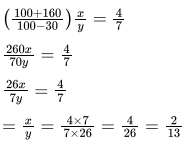CAT Exam > CAT Questions > The numerator of a fraction is increase by 1...
Start Learning for Free
The numerator of a fraction is increase by 160% and the denominator is decreased by 30%. If the resultant fraction is (4/7). What is the original fraction?
- a)(4/13)
- b)(1/13)
- c)(2/13)
- d)(5/13)
- e)(3/13)
Correct answer is option 'C'. Can you explain this answer?
Verified Answer
The numerator of a fraction is increase by 160% and the denominator i...
Let the original fraction be (100x/100y). then,
View all questions of this test
According to the question,

The original fraction = 2/13

|
Explore Courses for CAT exam
|

|
The numerator of a fraction is increase by 160% and the denominator is decreased by 30%. If the resultant fraction is (4/7). What is the original fraction?a)(4/13)b)(1/13)c)(2/13)d)(5/13)e)(3/13)Correct answer is option 'C'. Can you explain this answer?
Question Description
The numerator of a fraction is increase by 160% and the denominator is decreased by 30%. If the resultant fraction is (4/7). What is the original fraction?a)(4/13)b)(1/13)c)(2/13)d)(5/13)e)(3/13)Correct answer is option 'C'. Can you explain this answer? for CAT 2025 is part of CAT preparation. The Question and answers have been prepared according to the CAT exam syllabus. Information about The numerator of a fraction is increase by 160% and the denominator is decreased by 30%. If the resultant fraction is (4/7). What is the original fraction?a)(4/13)b)(1/13)c)(2/13)d)(5/13)e)(3/13)Correct answer is option 'C'. Can you explain this answer? covers all topics & solutions for CAT 2025 Exam. Find important definitions, questions, meanings, examples, exercises and tests below for The numerator of a fraction is increase by 160% and the denominator is decreased by 30%. If the resultant fraction is (4/7). What is the original fraction?a)(4/13)b)(1/13)c)(2/13)d)(5/13)e)(3/13)Correct answer is option 'C'. Can you explain this answer?.
The numerator of a fraction is increase by 160% and the denominator is decreased by 30%. If the resultant fraction is (4/7). What is the original fraction?a)(4/13)b)(1/13)c)(2/13)d)(5/13)e)(3/13)Correct answer is option 'C'. Can you explain this answer? for CAT 2025 is part of CAT preparation. The Question and answers have been prepared according to the CAT exam syllabus. Information about The numerator of a fraction is increase by 160% and the denominator is decreased by 30%. If the resultant fraction is (4/7). What is the original fraction?a)(4/13)b)(1/13)c)(2/13)d)(5/13)e)(3/13)Correct answer is option 'C'. Can you explain this answer? covers all topics & solutions for CAT 2025 Exam. Find important definitions, questions, meanings, examples, exercises and tests below for The numerator of a fraction is increase by 160% and the denominator is decreased by 30%. If the resultant fraction is (4/7). What is the original fraction?a)(4/13)b)(1/13)c)(2/13)d)(5/13)e)(3/13)Correct answer is option 'C'. Can you explain this answer?.
Solutions for The numerator of a fraction is increase by 160% and the denominator is decreased by 30%. If the resultant fraction is (4/7). What is the original fraction?a)(4/13)b)(1/13)c)(2/13)d)(5/13)e)(3/13)Correct answer is option 'C'. Can you explain this answer? in English & in Hindi are available as part of our courses for CAT.
Download more important topics, notes, lectures and mock test series for CAT Exam by signing up for free.
Here you can find the meaning of The numerator of a fraction is increase by 160% and the denominator is decreased by 30%. If the resultant fraction is (4/7). What is the original fraction?a)(4/13)b)(1/13)c)(2/13)d)(5/13)e)(3/13)Correct answer is option 'C'. Can you explain this answer? defined & explained in the simplest way possible. Besides giving the explanation of
The numerator of a fraction is increase by 160% and the denominator is decreased by 30%. If the resultant fraction is (4/7). What is the original fraction?a)(4/13)b)(1/13)c)(2/13)d)(5/13)e)(3/13)Correct answer is option 'C'. Can you explain this answer?, a detailed solution for The numerator of a fraction is increase by 160% and the denominator is decreased by 30%. If the resultant fraction is (4/7). What is the original fraction?a)(4/13)b)(1/13)c)(2/13)d)(5/13)e)(3/13)Correct answer is option 'C'. Can you explain this answer? has been provided alongside types of The numerator of a fraction is increase by 160% and the denominator is decreased by 30%. If the resultant fraction is (4/7). What is the original fraction?a)(4/13)b)(1/13)c)(2/13)d)(5/13)e)(3/13)Correct answer is option 'C'. Can you explain this answer? theory, EduRev gives you an
ample number of questions to practice The numerator of a fraction is increase by 160% and the denominator is decreased by 30%. If the resultant fraction is (4/7). What is the original fraction?a)(4/13)b)(1/13)c)(2/13)d)(5/13)e)(3/13)Correct answer is option 'C'. Can you explain this answer? tests, examples and also practice CAT tests.

|
Explore Courses for CAT exam
|

|
Signup for Free!
Signup to see your scores go up within 7 days! Learn & Practice with 1000+ FREE Notes, Videos & Tests.
























